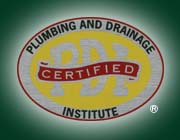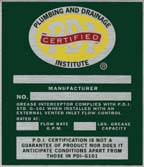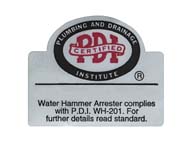
The Plumbing and Drainage Institute (PDI) is a trade association of manufacturers of engineered plumbing products. Our members make many items, including floor drains, roof drains, sanitary floor drains, cleanouts, water hammer arresters, fixture supports, interceptors, grease traps, hydrants and swimming pool drains.
The objective of the association is to promote the advancement of engineered plumbing products through publicity, public relations, research, and standardization of product requirements. PDI also works to prepare and publish standards relating to plumbing products. We desire to stimulate the growth of the industry through the expansion of its opportunities and to secure a wider market for our products.
The Institute (originally formed as the Plumbing and Drainage Manufacturer's Association) presently consists of 14 member companies and three licensees. (See "PDI Members and Licensees," p. 4.) There have been a number of executive secretaries over the years, the most recent of whom include: Scott Parrish, Jr., Richmond, VA, until 1962; Frank Uphues, Oak Park, IL, 1962-1972; Austin Roache, Jr., Indianapolis, IN, 1972-1988; and Sol Baker, Indianapolis, 1988-1996. I took over in 1996 as the executive director of the Institute.

PDI Standards
Grease InterceptorsPDI was an early leader in the development of standards to assist the plumbing industry. The first of these is Standard PDI G-101, Testing and Rating Procedure for Grease Interceptors.
Grease interceptors have been used in plumbing systems for well over 100 years to prevent grease accumulations from clogging piping and sewer lines. In the early 1940s, before the United State's entry into World War II, grease interceptors were specified for Army posts to meet the specifications of the Construction Division, Office of the Quartermaster General. These specifications called for interceptors that proved to be inadequate. It became apparent that a comprehensive engineering and testing program was required in order to properly rate grease interceptors. Apart from the prevention of clogged sewage systems, properly rated and sized grease interceptors were essential to the recovery of oils and grease so badly needed for the war effort.
As a result, a series of conferences were held involving the Research Committee of the Plumbing and Drainage Manufacturer's Association (now the Plumbing and Drainage Institute) and representatives of the Quartermaster General, Surgeon General, Army Corps of Engineers and others. These groups came together to establish flow rates and grease holding capacity for the uniform rating of the grease interceptors manufactured at that time.
The program that emerged from these conferences included exhaustive laboratory testing of each grease interceptor at the Iowa Institute of Hydraulic Research at the State University. This phase of the program was covered in a comprehensive report issued in August of 1945. Using the guidelines established in that report, the Research Committee continued the testing program at U.S. Testing Company Inc., Hoboken, NJ, which culminated with the first issue of Standard PDI G-101 in 1949 and certification of applicable interceptors.
PDI G-101 has been reprinted and updated many times, and it has stood the test of time, as it is still used by engineers and code officials to this day. PDI maintains a testing facility at Industrial Testing Laboratories, Inc. in Maryland Heights, MO, though Industrial Testing is an independent testing laboratory that is separate from PDI.
Units passing testing to PDI G-101 receive a certificate certifying that the unit has passed the test and that it is permitted to use the Institute's Seal Plate as proof of passing. In addition, certified units are periodically retested to make sure that they are current in their ability to intercept grease and keep it out of the effluent into the sewer system.
PDI G-101 became the basis for the ASME A112.14.3-2000 Grease Interceptor Standard. This standard introduced two new sizes for testing-namely 75 gpm and 100 gpm interceptors-along with additional methods of testing. In addition, PDI currently has a task group working on a standard for testing grease interceptors for an effluent level not to exceed 100 mg/l.
Water Hammer Arresters
The second standard readily recognized by the plumbing industry is PDI-WH 201 Water Hammer Arresters.
In the late 1950s and early 1960s, manufacturers developed engineered devices called water hammer arresters to control water hammer in piping systems. These were developed as an alternative to air chambers, which were the commonly used means of controlling water hammer at the time. Testing and field experience has shown that unless a means of recharging these items with air is provided, they quickly lose their charge of air and are rendered ineffective for controlling water hammer. Some air chambers lose their effectiveness in the first day of use.
PDI recognized that a means of proving that engineered devices worked to control water hammer was necessary and charged its Engineering Committee with doing the research and testing to develop a PDI standard for testing and certification of engineered water hammer arresters. This committee consisted of the following individuals: Louis Blendermann, Josam Mfg. Co; Gerrald Anderseon, Wade, Inc.; John Schmid, Zurn Industries, Inc.; and Joe Soriano, Jay R. Smith Mfg. Co. The committee worked for two years doing exhaustive testing and development, and Standard PDI WH 210 was finally published late in 1965.
Units passing PDI WH 201 receive a certificate testifying that the unit has passed the testing and is permitted to carry the Institute's Certification Seal as proof of passing. It should be noted that PDI WH 201 provides for periodic retesting to make sure that units continue to be current in their ability to control water hammer in piping systems.
In cooperation with the American Society of Sanitary Engineering (ASSE), PDI WH 201 was used as the basis for Standard ASSE 1010, Performance Requirements for Water Hammer Arresters.
PDI Standard WH 201 has been upgraded to include testing the "AA" size. The PDI test rig has been moved to CSA International, Cleveland, OH, the nationally recognized independent testing laboratory, and it is ready for testing as this article is being published.

Industry Involvement Helps Us Help You
PDI has been continuously represented on the ASME A112 Main Committee for Plumbing Materials and Equipment for many years, and our members have supported the efforts of this committee by allowing their personnel to participate in working groups to establish many standards for engineered plumbing products over the years. I am currently a member of this committee. I am also a member of the Uniform Plumbing Code Technical Committee, which reviews changes to the Uniform Plumbing Code, and I serve on the American Society of Plumbing Engineers (ASPE) Design Standards Main Committee.PDI also participates in various code hearings to keep our members updated as to what is happening in this important area of our business. These include the hearings of the International Association of Plumbing and Mechanical Officials (IAPMO), International Code Committee (ICC) and the National Plumbing Code (NPC), as well as others at the state level.
By being active on code committees, PDI is aware of what is happening in this important area and is able to keep our members informed of items that affect their interests. Presently, I am reviewing the code change proposals for both the International Plumbing Code and the Uniform Plumbing Code in order to advise our members on code changes that affect their products.
Because of our activity on standards committees, we know what is happening in this area and can communicate this to our members. This gives them an opportunity to have someone from their company volunteer to serve on a working group to help develop the standards that affect their products.
In an effort to keep the plumbing community informed, I also make myself available to groups such as plumbing inspectors, ASPE chapters and other organizations that are interested in hearing the PDI message. I have given many talks on the subject of FOG (fats, oils and grease) and how to keep it out of the waste stream from a building into the sewer system.
PDI also supports the engineering industry by participating in the ASPE Engineered Plumbing Exposition, which will be held Oct. 25 and 26, 2004, in Cleveland, OH. We hope to see you there.
In addition, PDI maintains a Web site at www.pdionline.org that offers our publications in PDF files that can be downloaded and printed. We invite you to visit our site and have a look around. You'll find a lot of information about the industry and about PDI's continuing efforts to improve the codes and standards that affect the plumbing community as a whole.
PDI Members and Licensees
Current Members:Canplas Industries, Ltd, Barrie, Ontario, Canada
Flexial Corp., Cookeville, TN
G.K.& L., Inc., Dickerson, MD
International GRD, Baltimore, MD
Josam Co., Michigan City, IN
Jay R. Smith Mfg. Co., Montgomery, AL
Lowe Engineering, Div. of Highland Tank, Friedens, PA
MIFAB, Etobicoke, Ontario, Canada
Rockford Sanitary Systems, Rockford, IL
Tempo Products Co., Solon, OH
Thermaco, Inc., Asheboro, NC
Wade Division/Tyler Pipe, Tyler, TX
Watts Regulator Co., North Andover, MA
Zurn Industries, Inc., Erie, PA
Licensees:
Bio-Microbics Inc., Shawnee Mission, KS
Grease Traps USA, Cincinnati, OH
Jonespec Div. of Zurn Industries, Falconer, NY